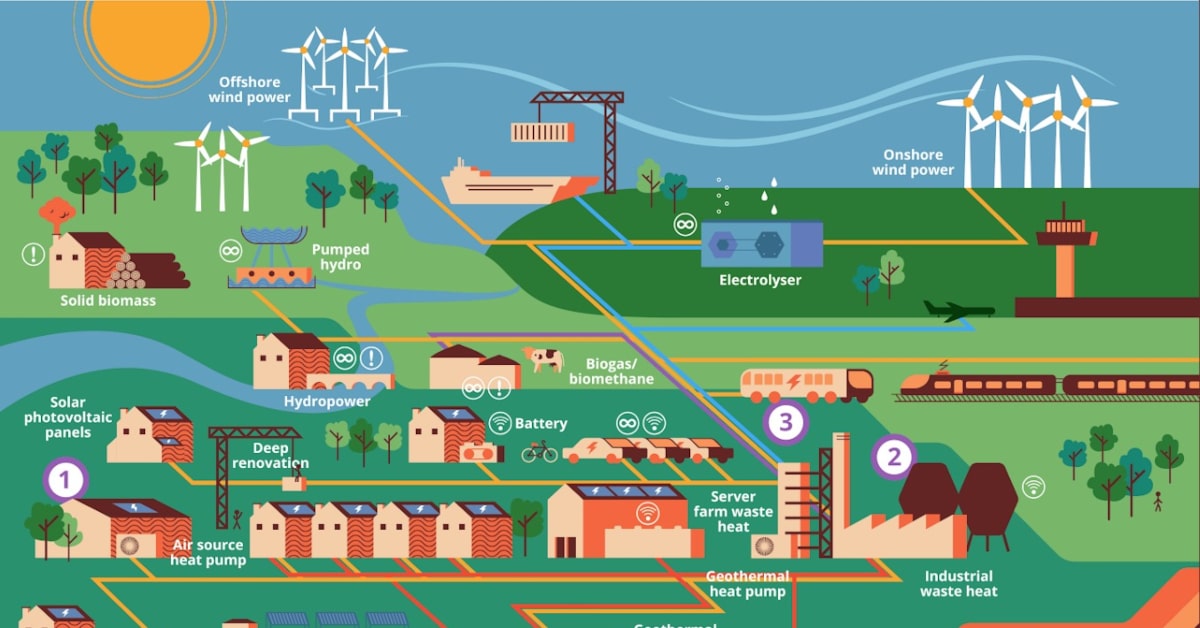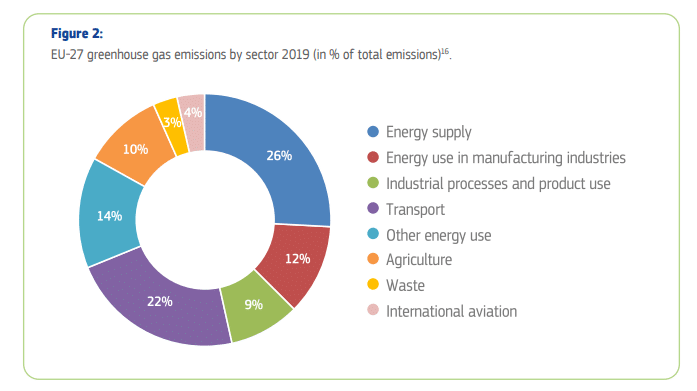
NECPs are National Energy and Climate Plans for 2021-2030 – These fundamental documents combine the targets, policies and measures planned by EU Member States to achieve their climate and energy commitments. Member States had to first submit these ten-year plans by the end of 2019 – as mandated by the Governance Regulation. This year NECPs need to be revised to reflect the EU Green Deal and the updated EU climate target for 2030 as well as the revised climate and energy legislation.
Europe is (supposed to be) in implementation mode already – we have to substantially change the way we produce and consume energy, build and renovate buildings, move around, transport goods, handle our waste and produce food – to cut net emissions by at least 55 % (or even more, if we want to keep to the Paris Agreement goal) within seven years from now. How do we do that?
The answer also lies in NECPs. These plans touch upon policies and measures related to almost every aspect of life and economy. To curb greenhouse gas emissions in line with the 1.5°C limit is an enormous task ahead, that requires an unprecedented level of action – for which NECPs should pave the way.
NECPs are a key tool to escape the climate crisis and build up the sustainable and secure energy system Europe desperately needs, especially now that the consequences of the fossil energy crisis following the Russian invasion of Ukraine are so apparent.
March 15, is the deadline for Member States to submit the first progress reports on how they have been implementing their NECPs. Countries must submit these progress reports (or NECPRs) every two years, starting from this year. Although the current plans were drafted before the most recent EU climate target and energy legislation – the ‘Fit for 55 package’ – came about, these progress reports will indicate if Member States are taking their reporting duties and climate and energy responsibilities seriously. These reports will show how far we are from where we have to be in terms of climate action.
Turning EU targets into national action
In 2021, Europe launched its ‘Fit for 55 package’, laying down 2030 EU climate and energy targets. The package is a set of legislative proposals aiming to ultimately deliver ‘at least net 55% emission reductions’ till 2030 (which would still leave a substantial gap to what is needed to ensure the EU is contributing its fair share to the global effort to stay within the 1.5 degrees limit).
Among the legislative files of the package, the Effort Sharing Regulation sets binding national emission reduction targets for buildings, road transport, agriculture, waste and small industry. In other words, it prescribes the minimum level of emission reduction each Member State has to deliver in these sectors in order to contribute to the common European climate goal.
The 2030 EU-wide renewable energy and energy efficiency targets, instead, are set by the Renewable Energy Directive and the Energy Efficiency Directive. In their NECPs, Member States need to show how they will contribute to achieve these EU-wide targets together.
The HOW — the policies, measures and plans that EU Member States intend to formulate to deliver their obligations – should also be described in their NECPs, as required under the Governance Regulation.
EU countries drafted their first NECPs in 2018-2019 and had to submit the final versions by the end of 2019. However, almost the minute the ink dried on the first NECPs, they became obsolete in the light of the EU Green Deal and the new emissions reduction level needed until 2030 and towards achieving climate neutrality by mid-century. Now, five years after their first submission, the update of NECPs represents a unique opportunity to accelerate national climate action and energy transition across the EU.
How far are we and are NECPs the right vehicle?
CAN Europe and its members analysed the first round of NECPs in 2022 and came to the conclusion that, in their current form and with their insufficient level of ambition, NECPs are dramatically unfit for purpose – especially in light of the increased ambition of the Fit for 55 legislative package and the ‘REPowerEU’ plan in response to Russia’s invasion of Ukraine. Member States have a lot of action to catch up with. In the decade leading up to 2020, several economic sectors failed to meaningfully reduce emissions. Actually, instead of decreasing, emissions in certain sectors have been on the rise or stagnating.
According to the European Commission’s latest 2021 Climate Progress Report, with the implementation of the additional measures in current NECPs the EU is projected to reduce its emissions in the Effort Sharing Regulation sectors only by 30% in 2030. This level of ambition is far below what would be required to be in line with the EU’s Paris Agreement commitments (at least 50% reduction by 2030 in these sectors); it is not even in line with the current EU target of 40% in ESR sectors. Clearly, a lot of additional measures will have to be planned and implemented in order to improve NECPs this year.
Today we are obviously facing a very different reality compared to when the first NECPs were finalised. Apart from the increased climate target, we have to take into account the response to the Russian invasion of Ukraine and the new scientific data that alerts of more frequent and catastrophic climate impacts, thus the need to stop using fossil fuels overall, ambitiously curb energy demand, ramp up sustainable renewables and roll out flexibility options urgently. In the remaining seven years until the end of the decade, NECPs should guide countries to fundamentally overhaul their energy systems.
Greenhouse gas emissions by sector in the EU 27 – to illustrate the sectors we need to rapidly decarbonise
Source – European Commission, 2019
The civil society-driven Paris Agreement Compatible (PAC) Energy Scenario and a recent report by Climate Analytics show that it is still possible to achieve a fully renewable energy system and reach a safe climate compatible goal for the EU by 2040. However, although the tools are readily available and the solutions are well known, the current action is not in line with what is required.
The deadline for Member States to come up with their new draft NECPs – June 2023 – is swiftly approaching. The new final revised plans – which should factor in feedback from the European Commission and views of the public – will then have to be submitted in June 2024. This revision is an essential moment for EU Member States to set things right – to bring NECPs much closer to their real, transformative potential. More ambitious NECPs should help to keep global warming to 1.5°C, while at the same time ensuring energy security and more equity and justice in Europe.
PREVIOUS
NEXT

